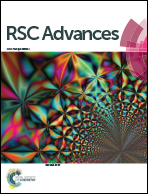Glycerol as green hydrogen source for catalytic reduction over anisotropic silver nanoparticles†
Abstract
The search for nanomaterials for catalysis of transfer hydrogenation reactions with green hydrogen sources is an important topical issue. In this work we show that anisotropic silver nanoparticles act as efficient catalysts for p-nitrophenol (Nip) reduction with glycerol, a renewable biomass byproduct, as the green hydrogen source. Anisotropic silver nanoparticles (AgNPs) were prepared using polyol method in presence of Cu2+ salt as an etchant. These AgNPs are found to be a combination of mixture of anisotropic shapes and spherical faceted nanoparticles. The percentage of anisotropic shapes in the distribution changes with amount of etchant used. Effect of shape and size of AgNPs on the catalytic kinetics of Nip reduction using glycerol as a hydrogen source was investigated. The AgNPs sample having more nanoparticles with anisotropy and finer average particle size exhibits better kinetics, lower activation energy and better turnover frequency (TOF).


 Please wait while we load your content...
Please wait while we load your content...